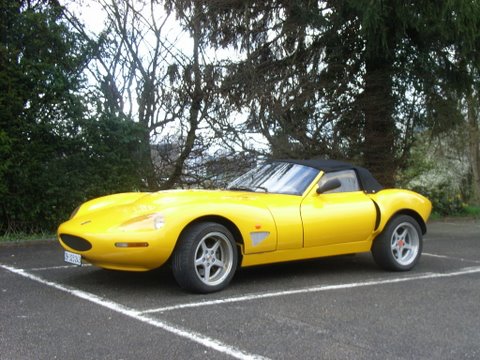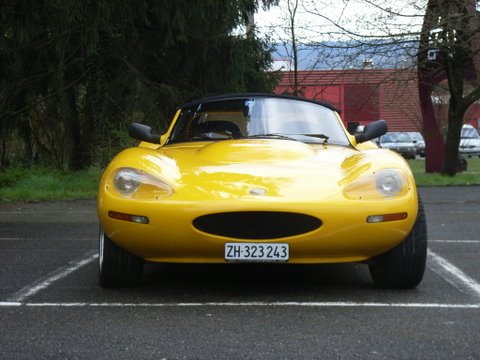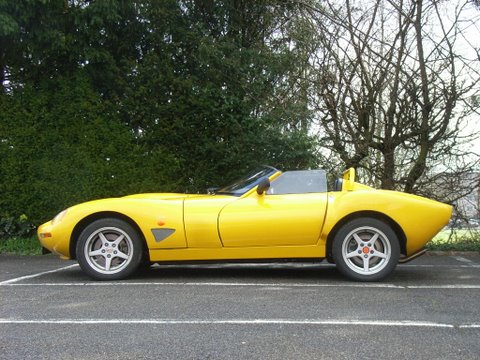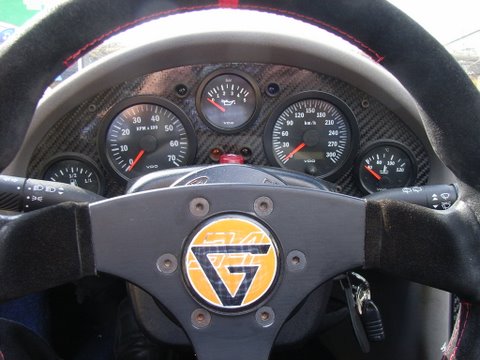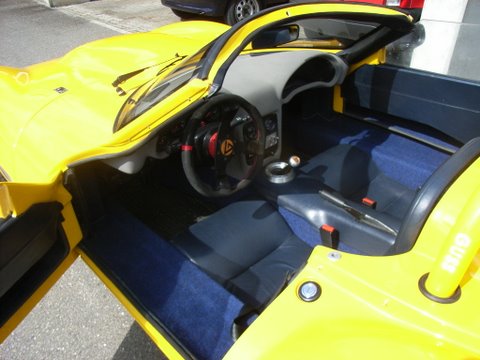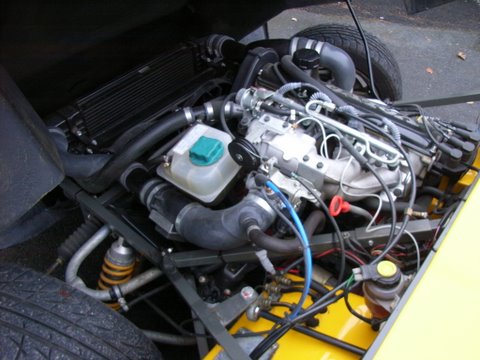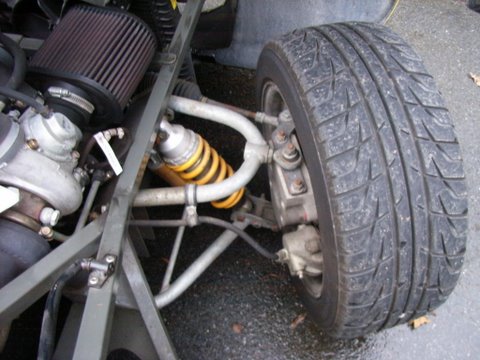The G34 was a brave project to produce a "Ginetta" in Sweden with unofficial help from Volvo.
This article from Performance Car April 1995 shows some of the hopes then for the new car.
Unfortunately the project folded after only a few cars were made.
A LONG WAY FROM SCUNTHORPE

You get used to the less-than-evocative names that are home to the British sportscar. and Blackpool may not have the romance of Modena, but it does have a splendid tower and TVR lives there. Dartford is home to a tunnel and Caterham, while Westfield is based in Kingswinford, which sounds majestic and isn't far from Wolverhampton. Ginetta, though, is breaking the mould (an unintended pun). The next Ginetta sportscar, the G34, will come, not from Ginetta's traditional home in Scunthorpe, but from Arvika -Arvika in Sweden, of course. Never heard of it? No, it's not the obvious place to build a sportscar, but Arvika is close to Gothenberg, which happens to be home to Volvo's huge manufacturing plant. Ginetta, more used to Ford or Rover V8 power, will soon have a brand new, fully type-approved car using, yes, you guessed it, Volvo turbo-power. And it'll be built in Arvika. If, like me, you're now scratching your head and asking how on earth this came about, read on; if not, put Performance Car down and read the Radio Times instead.
Back in 1992, Ginetta was on the brink of disappearing for good. A consortium of Ginetta agents eventually saved the company, and we're not just talking UK here -the new Ginetta is truly European, owned jointly by dealers in Belgium, France, Sweden, a dealer in the UK and Martin Phaff, who heads up the small manufacturing base which soon moved to new premises in Sheffield. All the partners agreed that the company desperately needed a type-approved car that could be sold fully built and within the steadily advancing EC regulations. Martin got the message loud and clear, and began to develop a car. Funds were needed to expand, but they failed to materialise and the deal fell through Meanwhile, in Sweden, where money lenders are a little more understanding, Ingemar Engstrom, the Scandinavian partner, had been pursuing his own avenue and the Swedish government (in total contrast) wanted to help. Ingemar ,was put in touch with Bengt Lidnialm, a retired Volvo director, who had a serious hobby building his one car, the indigo, a TVR Chimera look a like with a Volvo engine. Nominally Volvo won't talk to anyone who isn't in the market for least 5000 engines, but Bengt has friends in high places it seems he was a good director

Ginetta's macho curves now hides Volvo mechanicals and know-how (and hopefully build quality).
Bengt, was interested, and had room in his Arvika plant to build the G34 and his lndigo side by side. He and lngemar set up a new company and brought in a new MD Irigolf Elmhammar. Great names, huh? The new company was called Gin 1, after Martin Phaff had expressed reservations about using the Ginetta name directly. It makes sense'I' in Swedish is :Etta', so all Swedes who see this name ,written down say Gin Etta anyway. Gin 1 then bought the rights to use the Ginetta G33 moulds, the company's sleek sport car. A new chassis, based on a stretched G33 frame, was built, and using Bengt's contacts, Volvo components; fresh from the factory and with the blessing of the management, were attached Volvo suspension and brakes were used; the rear assembly being taken straight from the 960,The Volvo turbo-charged four cylinder 2.0litre engine was chosen, because it provides lots of power (when it comes to the UK 190bhp should be on tap) and two litres gets a tax break inmost European countries, including Sweden Volvo's unofficial involvement is curious. The company isn't coming forward with hard Swedish kronas, but the enthusiasm and support is nevertheless there. lngolf describes the company's input as 'doing favours' and 'providing resources' which means so far all the type approval work, emission testing, and access to test tracks has come free of charge. When we drove the car, the first magazine to do so, it was at the Volvo test track on their huge Torslanda assembly site. So far there are two G34s, which are coloured red and yellow like the famous tongue twister. The yellow car is the mule, the prototype which is mechanically correct, but is, by Gin l's own admission, a bit rough The red car is the first real G34, and it shows how the G34 will look The body is long, wide and low, with an enormous double hump on the bonnet that gives the car an aggressive, broken nose look - it's there to hide the Volvo engine which looks great in the car The lights, cut out of the bonnet, will be MX3 sealed units, not the rather messy affair mocked up when we arrive amidst the freezing Swedish sleet to see the car. Like the interior ,details like these suggest the car still needs lots of work The interior itself, made almost entirely from carbon fibre, is very promising, though a Caterham 21-style double bubble facia is clearly emerging, although the dials and switchgear are missing. Gin 1 is currently considering using Volvo switches, too a good idea if the G34 is to achieve consistency, and avoid that 'cobbled together' kit car feel. The yellow car is the one we drive the next day, thankfully in some chilly northern sunshine. Its interior consists of bare plastic, the body is botched, but as soon as the engine starts, you know this is no dog The soft burble is clearly from a modern, well-timed engine, with just a touch of harshness you won't hear from a Volvo. Once ensconced in the low, lie-back seats, you notice that both the steering wheel and aluminium gear knob are perfectly placed The driving position is good, despite slightly offset pedals. I let the progressive clutch out, and I'm off Ingemar reckons this Swedish spec engine produces about, 165bhp, 25bhp less than the planned UK version, and almost immediately I decide that's plenty for a car that weighs so little. Ingemar is a bit of a Swedish Gordon Murray, obsessed by weight, and the car if pared to the minimum (he wants a carbon, fibre interior for that reason, ,not because it looks nice). On the move, the gruff exhaust can't be heard, and instead the whistle and whir of the turbo fills my ears. The engine is strong, and after a little lag, the wheels will spin easily in first and second. Go easy on the throttle, though, and the power will tow the car strongly down the road. Snatch third, and now a full throttle can be used. Third and fourth, through the precise Volvo gearbox, both pull hard, and the car gathers speed strongly without any let up; fifth drops you again right in the power band, up to an estimated 130mph-plus. The engine is powerful and compelling; the 5 sec's 0-60mph and 14secs quarter mile times that Ginetta UK expects seem utterly possible. The grip needed for acceleration in first and second is lacking in the yellow car -the nearly bald tyres are useless for starters, it's practically out of fuel, making the rear as light as any rear can be, and the suspension seems very harsh. As well as the gutsy acceleration, these factors conspire to make the handling a little suspect. Getting The tail out is easy, and getting it back should be simple too: The steering is sharp, and apart from a little play in this prototype, it's very responsive. The steering can't help though: The lack of rear grip means once The car slips wildly, it doesn't stop until you're facing the wrong way. Decent tyres will obviously make a big difference, but a little loosening of the suspension set-up might also help by allowing the wheels to sink their rubbery teeth more firmly into the tarmac. If Gin 1 spends another six months getting this car right (don't expect to get one next week), the Swedish G34 could be a great light sports car. At an estimated UK price of £24,000, it won't be cheap, but it'll be different, it'll be quick, and it'll definitely be a driver's car. By combining the yellow car's strong engine and razor sharp chassis with the red car's beefier looks and more thoughtful design, it'll be a real Caterham 21 rival. I'm convinced 'Made in Sweden' Ginettas will soon have their own niche fan club. And I can't wait to drive the finished article.

Probably the last name you would expect to find under the Ginetta Bonnet, but Volvo turbo power guarantees great performance.

The cabin is not finished, but the design is good and the abundant use of carbon fibre provides a modern sporty feel.

Fitting the Volvo engine required a large double power bulge. Windscreen corners squared off and pop up headlights replaced with flared in units. This car was a Prototype.
The following photos are from a Swiss owner.
It's number 21 from 21 produced cars, (in variour formats) has about 8500 miles and the engine delivers about 230 to 240 HP.
Year of production: 1997
